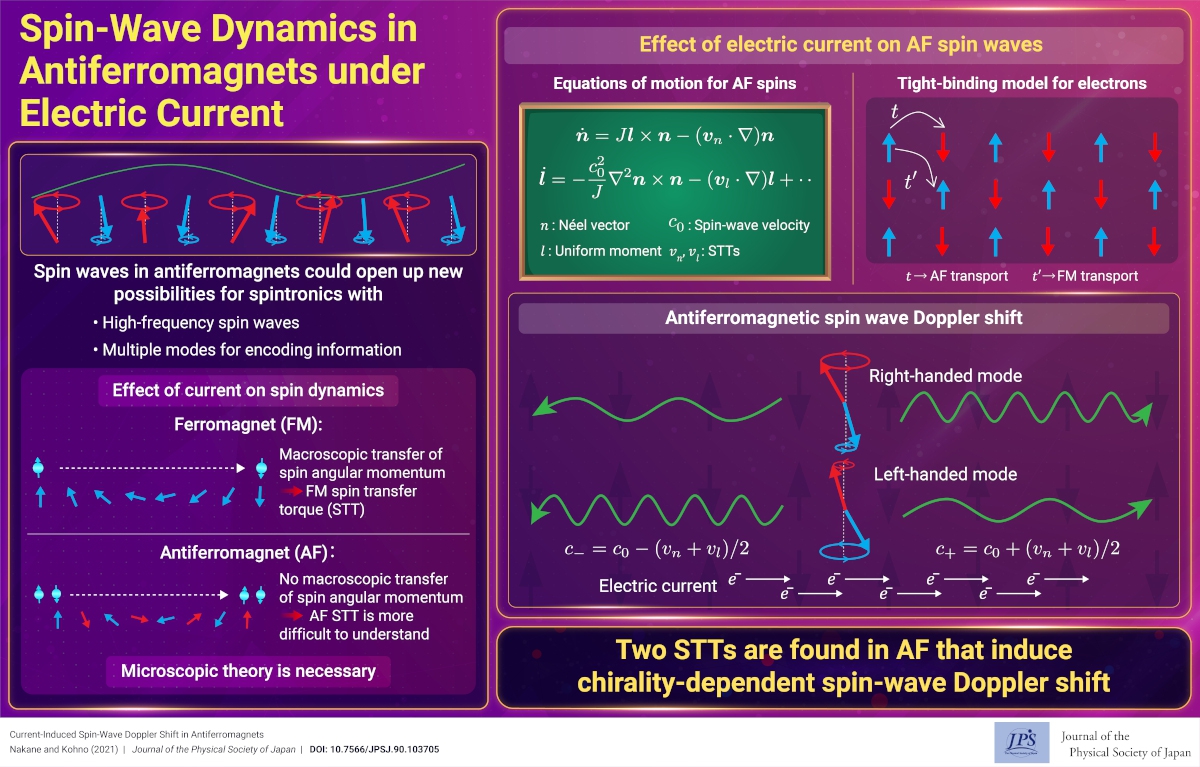Spin-Wave Dynamics in Antiferromagnets under Electric Current
© The Physical Society of Japan
This article is on
J. Phys. Soc. Jpn.
90,
103705
(2021)
.
Electric current causes a Doppler effect in spin waves in ferromagnets through a spin-transfer torque. We report that antiferromagnets allow two such spin-transfer torques and present a microscopic analysis that interpolates ferro- and antiferromagnetic transport regimes.

Investigating the effect of electric current on magnetic materials is crucial in spintronics. In ferromagnets, electric currents are known to drive domain-wall motion and cause a Doppler shift in the spin-wave spectrum. These phenomena, known as the spin-transfer effect, can be understood as the exchange of spin angular momentum between magnetization and conduction electrons. In antiferromagnets, neither the conduction electrons nor antiferromagnetic spins carry macroscopic spin angular momentum, and the spin-transfer effect is not intuitively understood, calling for a microscopic analysis.
It was long supposed that there is only one (reactive) spin-transfer torque in antiferromagnets, as in ferromagnets. In this study, starting from a microscopic Hamiltonian with conduction electrons, we show that antiferromagnets have two different types of spin-transfer torques: one arising through the coupling to the uniform spin density ( ) and the other through the staggered spin density ( ). The two spin-transfer torques make equal contributions of to the spin-wave Doppler shift, while only one ( ) acts on domain walls [1]. This feature is in stark contrast to ferromagnets, in which a single spin-transfer torque leads to both Doppler shift and domain-wall motion. The Doppler shift depends on chirality of antiferromagnetic magnons, thus an electric current can be used to differentiate the two modes via the shift in wavelength or frequency.
We microscopically calculated the spin-transfer torques due to electrons on a two-dimensional square lattice by considering not only the nearest-neighbor (inter-sublattice) hopping but also the next-nearest-neighbor (intra-sublattice) hopping; the former induces “antiferromagnetic transport” in the sense that the electrons feel the alternating magnetization, whereas the latter induces “ferromagnetic transport,” rendering the electrons feel a uniform magnetization. One can interpolate the two transport regimes (ferromagnetic and antiferromagnetic) by varying the hopping parameters. In the limit of ferromagnetic transport, the two spin-transfer torques reduce to the well-known spin-transfer torque in a ferromagnet. In the antiferromagnetic transport regime, the two torques collaborate or compete, and the overall Doppler shift depends on microscopic parameters (such as band filling); it is negative (same sign as for ferromagnets) at small band filling and changes sign as the lower band becomes filled towards the antiferromagnetic band gap.
[1] J. J. Nakane and H. Kohno, Phys. Rev. B 103, L180405 (2021).
(Written by J. Nakane on behalf of all authors)
J. Phys. Soc. Jpn.
90,
103705
(2021)
.
Share this topic
Fields
Related Articles
-
Higher-Order Topological Phases in Magnetic Materials with Breathing Pyrochlore Structures
Electronic structure and electrical properties of surfaces and nanostructures
Magnetic properties in condensed matter
Mathematical methods, classical and quantum physics, relativity, gravitation, numerical simulation, computational modeling
2025-4-7
A simple example of a higher-order topological phase, in which the symmetry decreases step-by-step from the bulk to the corner, is realized in a magnetic system with a pyrochlore structure and is characterized by a series of quantized Berry phases defined for the bulk, surface, and edge.
-
Existence of Chiral Soliton Lattices (CSLs) in Chiral Helimagnet Yb(Ni1-xCux)3Al9
Magnetic properties in condensed matter
2025-4-1
Our study examines the magnetic structure of the monoaxial chiral helimagnet Yb(Ni1-xCux)3Al9, providing first direct evidence of the formation of chiral soliton lattice state.
-
Understanding Pressure-Induced Superconductivity in CrAs and MnP
Magnetic properties in condensed matter
2025-3-10
This study reviews existing research on the pressure-induced variation of magnetic properties of transition metal mono-pnictides like CrAS, MnP, and others, aiming to understand the unconventional superconductivity observed in CrAs and MnP.
-
A Unified Theory of Topological Hall Effect
Electronic transport in condensed matter
2025-3-6
This paper presents a unified theoretical description for the topological Hall effect, covering the entire region from strong- to weak-coupling, extending its picture beyond the Berry phase.
-
Excitonic Insulators: Challenges in Realizing a Theoretically Predicted State of Matter
Electron states in condensed matter
Electronic transport in condensed matter
2025-3-3
The realization of an excitonic insulator can help in the establishment of a new electronic state in condensed matter physics, one that has the potential to exhibit novel electric, magnetic, and optical responses beyond those of conventional materials.




